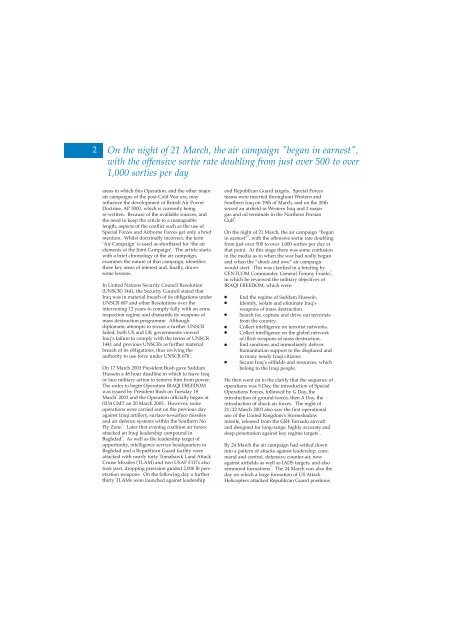Volume 6 No 4 - Royal Air Force Centre for Air Power Studies
Volume 6 No 4 - Royal Air Force Centre for Air Power Studies
Volume 6 No 4 - Royal Air Force Centre for Air Power Studies
Create successful ePaper yourself
Turn your PDF publications into a flip-book with our unique Google optimized e-Paper software.
2<br />
On the night of 21 March, the air campaign "began in earnest",<br />
with the offensive sortie rate doubling from just over 500 to over<br />
1,000 sorties per day<br />
areas in which this Operation, and the other major<br />
air campaigns of the post-Cold War era, may<br />
influence the development of British <strong>Air</strong> <strong>Power</strong><br />
Doctrine, AP 3000, which is currently being<br />
re-written. Because of the available sources, and<br />
the need to keep the article to a manageable<br />
length, aspects of the conflict such as the use of<br />
Special <strong>Force</strong>s and <strong>Air</strong>borne <strong>Force</strong>s get only a brief<br />
mention. Whilst doctrinally incorrect, the term<br />
‘<strong>Air</strong> Campaign’ is used as shorthand <strong>for</strong> ‘the air<br />
elements of the Joint Campaign’. The article starts<br />
with a brief chronology of the air campaign,<br />
examines the nature of that campaign, identifies<br />
three key areas of interest and, finally, draws<br />
some lessons.<br />
In United Nations Security Council Resolution<br />
(UNSCR) 1441, the Security Council stated that<br />
Iraq was in material breach of its obligations under<br />
UNSCR 687 and other Resolutions over the<br />
intervening 12 years to comply fully with an arms<br />
inspection regime and dismantle its weapons of<br />
mass destruction programme. Although<br />
diplomatic attempts to secure a further UNSCR<br />
failed, both US and UK governments viewed<br />
Iraq’s failure to comply with the terms of UNSCR<br />
1441 and previous UNSCRs as further material<br />
breach of its obligations, thus reviving the<br />
authority to use <strong>for</strong>ce under UNSCR 678 1 .<br />
On 17 March 2003 President Bush gave Saddam<br />
Hussein a 48 hour deadline in which to leave Iraq<br />
or face military action to remove him from power.<br />
The order to begin Operation IRAQI FREEDOM<br />
was issued by President Bush on Tuesday 18<br />
March 2 2003 and the Operation officially began at<br />
0234 GMT on 20 March 2003. However, some<br />
operations were carried out on the previous day<br />
against Iraqi artillery, surface-to-surface missiles<br />
and air defence systems within the Southern <strong>No</strong><br />
Fly Zone 3 . Later that evening coalition air <strong>for</strong>ces<br />
attacked an Iraqi leadership compound in<br />
Baghdad 4 . As well as the leadership target of<br />
opportunity, intelligence service headquarters in<br />
Baghdad and a Republican Guard facility were<br />
attacked with nearly <strong>for</strong>ty Tomahawk Land Attack<br />
Cruise Missiles (TLAM) and two USAF F117s also<br />
took part, dropping precision guided 2,000 lb penetration<br />
weapons. On the following day a further<br />
thirty TLAMs were launched against leadership<br />
and Republican Guard targets. Special <strong>Force</strong>s<br />
teams were inserted throughout Western and<br />
Southern Iraq on 19th of March, and on the 20th<br />
seized an airfield in Western Iraq and 2 major<br />
gas and oil terminals in the <strong>No</strong>rthern Persian<br />
Gulf 5 .<br />
On the night of 21 March, the air campaign “began<br />
in earnest” 6 , with the offensive sortie rate doubling<br />
from just over 500 to over 1,000 sorties per day at<br />
that point. At this stage there was some confusion<br />
in the media as to when the war had really begun<br />
and when the “shock and awe” air campaign<br />
would start. This was clarified in a briefing by<br />
CENTCOM Commander, General Tommy Franks 7 ,<br />
in which he reviewed the military objectives of<br />
IRAQI FREEDOM, which were:<br />
End the regime of Saddam Hussein.<br />
Identify, isolate and eliminate Iraq’s<br />
weapons of mass destruction.<br />
Search <strong>for</strong>, capture and drive out terrorists<br />
from the country.<br />
Collect intelligence on terrorist networks.<br />
Collect intelligence on the global network<br />
of illicit weapons of mass destruction.<br />
End sanctions and immediately deliver<br />
humanitarian support to the displaced and<br />
to many needy Iraqi citizens.<br />
Secure Iraq’s oilfields and resources, which<br />
belong to the Iraqi people.<br />
He then went on to the clarify that the sequence of<br />
operations was S Day, the introduction of Special<br />
Operations <strong>Force</strong>s, followed by G Day, the<br />
introduction of ground <strong>for</strong>ces, then A Day, the<br />
introduction of shock air <strong>for</strong>ces. The night of<br />
21/22 March 2003 also saw the first operational<br />
use of the United Kingdom’s Stormshadow<br />
missile, released from the GR4 Tornado aircraft<br />
and designed <strong>for</strong> long-range, highly accurate and<br />
deep penetration against key regime targets 8 .<br />
By 24 March the air campaign had settled down<br />
into a pattern of attacks against leadership, command<br />
and control, defensive counter-air, now<br />
against airfields as well as IADS targets, and also<br />
armoured <strong>for</strong>mations 9 . The 24 March was also the<br />
day on which a large <strong>for</strong>mation of US Attack<br />
Helicopters attacked Republican Guard positions
















